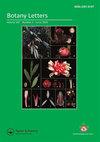亚历山大·冯·洪堡和艾姆斯·邦普兰在《植物》Équinoxiales(1805-1817)中描述的有用植物
IF 1.3
4区 生物学
Q3 PLANT SCIENCES
引用次数: 1
摘要
亚历山大·冯·洪堡和艾姆斯·邦普兰从欧洲出发前往美洲大陆。这些博物学家探索了美国的生物多样性,在1799年至1804年间收集了大约6000种植物,并记录了当地人的风俗习惯。迄今为止,洪堡和邦普兰在他们的美国之旅中所报告的药用和有用的植物还没有被深入研究过。本报告的目的是介绍两位自然学家在他们的著作《洪堡和邦普兰之旅》中记录的数据。第六部,植物园。Plantes Équinoxiales(卷一和卷二),出版于1805年至1817年,共17部分,涉及他们收集的药用和有用植物。关于植物的数据是从两卷本的工作中获得的,该工作存放在巴西库里蒂巴联邦帕拉纳大学本文章由计算机程序翻译,如有差异,请以英文原文为准。
Useful plants described in the Plantes Équinoxiales (1805–1817) by Alexander von Humboldt and Aimé Bonpland
ABSTRACT Alexander von Humboldt and Aimé Bonpland departed from Europe on a journey to the American continent. The naturalists explored America’s biodiversity, collecting approximately 6,000 plant species between 1799 and 1804 and registering the customs and habits of local people. To date, the medicinal and useful plants reported by Humboldt and Bonpland during their American journey have not been studied in depth. The aim of the present report is to present data recorded by both naturalists in their books Voyage de Humboldt et Bonpland. Sixième Partie, Botanique. Plantes Équinoxiales (Volumes I and II), published from 1805 to 1817 in 17 parts, regarding medicinal and useful plants collected by them. Data on plants were obtained from the two-volume work, which was deposited and accessed in the library of the Biological Sciences Sector of Universidade Federal do Paraná, Curitiba, Brazil. Traditional information about the plants was translated and tabulated. The botanical identification of each plant was updated according to current nomenclature. Correlated pharmacological studies were obtained from scientific databases. A total of 130 plant species from 49 different botanical families are described in the Humboldt’s and Bonpland’s Plantes Équinoxiales books. Fourteen species were reported for medical purposes (snake anti-venom agents, treatment of cutaneous and digestive diseases, and astringent agents), while 65 species were described for some other use (ornamental, construction, furniture and objects, edible plants, dyeing, mining etc.). The data recorded by these naturalists represent a rich unexplored source of information regarding the American flora and its traditional uses.
求助全文
通过发布文献求助,成功后即可免费获取论文全文。
去求助
来源期刊

Botany Letters
Agricultural and Biological Sciences-Plant Science
CiteScore
3.10
自引率
6.70%
发文量
54
期刊介绍:
Botany Letters is an international scientific journal, published by the French Botanical Society (Société botanique de France) in partnership with Taylor & Francis. Botany Letters replaces Acta Botanica Gallica, which was created in 1993, building on over a century of renowned publications by the Société botanique de France.
 求助内容:
求助内容: 应助结果提醒方式:
应助结果提醒方式:


